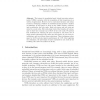61 search results - page 4 / 13 » Nested Codes for Constrained Memory and for Dirty Paper |
HIPEAC
2007
Springer
14 years 1 months ago
2007
Springer
Abstract. The interest in translation-based virtual execution environments (VEEs) is growing with the recognition of their importance in a variety of applications. However, due to ...
ISCA
2011
IEEE
12 years 11 months ago
2011
IEEE
Due to shrinking feature sizes processors are becoming more vulnerable to soft errors. Write-back caches are particularly vulnerable since they hold dirty data that do not exist i...
IPPS
2007
IEEE
14 years 1 months ago
2007
IEEE
With the increasing gap between processor speed and memory latency, the performance of data-dominated programs are becoming more reliant on fast data access, which can be improved...
DCC
2008
IEEE
14 years 7 months ago
2008
IEEE
In a previous paper we derived an upper bound on the redundancy of an arithmetic-type encoder for a memoryless source, designed to meet a finite endto-end strict delay constraint....
KBSE
2005
IEEE
14 years 1 months ago
2005
IEEE
Software for resource constrained embedded devices is often implemented in the Java programming language because the Java compiler and virtual machine provide enhanced safety, por...

